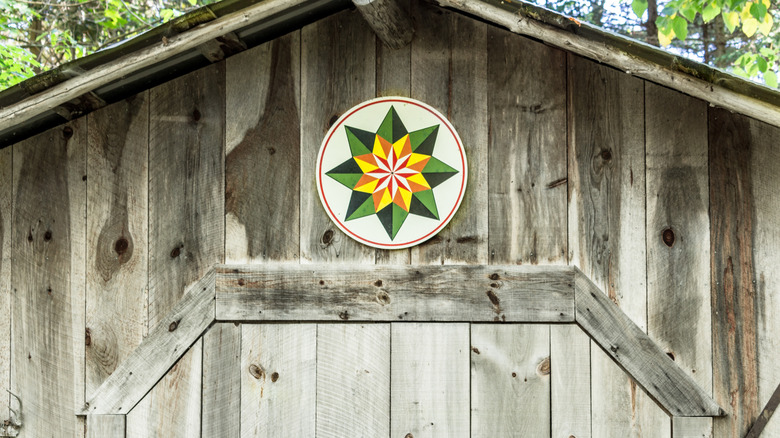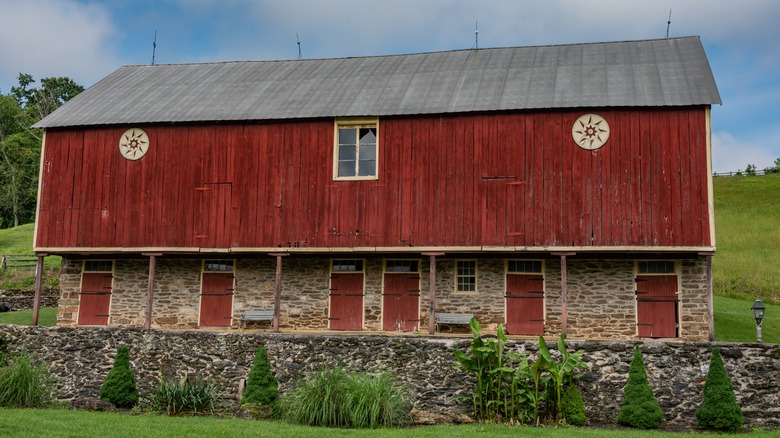If You See These Colorful Hex Signs On A Home, This Is What It Means
Secret symbols, especially beautiful ones, bring a touch of magic to daily life. Around the U.S., there are regional artistic phenomena that you see often enough to raise your curiosity. Blank walls commonly become canvases for artistic expression. You might spy an outsized metal star on the side of someone's home or Crayola-colored barn quilts that make farms more festive. But there are other mysterious designs that pop up in isolated areas, especially in Pennsylvania, whose names suggest a hint of something spooky.
Hex signs, more accurately called Schtanne (stars) or Blumme (flowers) in Pennsylvania Dutch, are circular paintings that pop up on many a southeastern Pennsylvania home, barn, or other building. Schtanne and Blumme show off bright contrasting colors and geometric patterns that come together to make a folksy star or flower shape. The name "hex sign" suggests a mystical or supernatural origin, but it's in fact more of a misnomer. They are instead an imitation by early settlers of agricultural and celestial art painted on buildings in central Europe.
A short history of Schtanne
The Pennsylvania Dutch put down their roots in the southeastern corner of Pennsylvania in the mid 1600s. Emigrants from what's now Germany, Switzerland, southern Poland, western France, and the Czech Republic brought their language and culture with them to the New World and established the Pennsylvania Dutch communities. Although no one is truly certain when painting Schtanne on barns and other buildings began, there are structures dating to the late 1700s that boast these colorful stars. Designs on these Schtanne harken back to ones that were often painted or carved into buildings in the Old World.
In the mid-20th-century, tourist guidebooks brought Schtanne to light for visitors outside of Pennsylvania Dutch country. Maybe due to a misunderstanding or maybe to spark readers' curiosity, these guidebooks coined the term "hex stars" for this art form. The supernatural-tinged name led to the outsider myth that Schtanne were protection from evil. However, community members brush off that interpretation. People who own buildings decorated with Schtanne admit that the paintings likely had a variety of meanings over the years, and depending on who painted them.
Put a hex on your house
Artisans in Pennsylvania Dutch country are bringing Schtanne to the mainstream, and adorning your home with one can be a shout-out to your own Germanic heritage if you have any, or it can simply showcase an art form that's been active for centuries. A Schtanne is a savvy way to incorporate art in your yard or in any room of your house.
Scores of Schtanne artisans are ready to ship their handmade wares your way. You can find both round and oval-shaped Schtanne at Hexsign.com, where this family business has been marketing their signs since 1959. For a wider variety, including antique Schtanne, Etsy is a reliable resource.
Or try DIYing a Schtanne — it's possible even for the unartistic. You can lay out a geometric, symmetrical form like Vanessa Sorensen does in her blog Nessy Designs. Sorensen mocked up a Schtanne with the help of computer illustration software. The four-piece printout of the mock up became a stencil to transfer the design to a wooden board. Sorensen traced and painted the pattern onto the wood, attached hanging hooks to the back, and it was ready for display.

